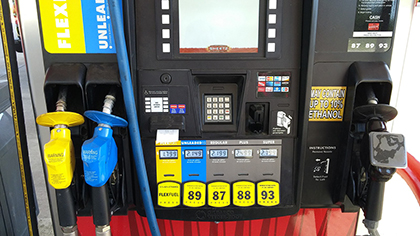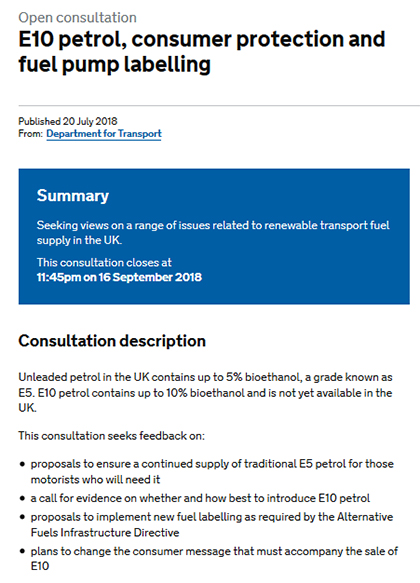 United States – UK – Europe – Most of the time when writing about an issue, because of our background we have a very workable understanding or lead on the topic.
United States – UK – Europe – Most of the time when writing about an issue, because of our background we have a very workable understanding or lead on the topic.
However sometimes we rely on those who have an understanding on the issue which the subject of concern in this case, is Ethanol in petrol. Ethanol is essentially grain alcohol produced from crops, that is mixed with gasoline to produce an ethanol-gasoline blend motor fuel.
In 2012 as Right To Ride EU we reported the concerns from riders and their representative organisations in the United States – Ethanol – USA – and the UK – Ethanol in Petrol – regarding Ethanol in petrol.
This has remained the same from 2012 to 2018 regarding the effect on mainly older vehicles with the UK Government issuing a public consultation and in the United States the rider organisations lobbying their government.
As we write this piece, the Federation of European Motorcyclists’ Associations (FEMA) have published – Fuel labelling: information to help you choose the right fuel – a consumer article that highlights that, “CEN standard has drawn up common symbols, or ‘fuel identifiers’, that will be placed on new vehicles and fuel pumps. These identifiers must be in place by October 2018.” which links to ACEM – motorcycle manufacturer’s representative organisation in Europe list of their members petrol vehicles that are compatible with E10 petrol
Having produced an article in July Will ethanol-blended fuel damage my motorcycle? The British Motorcyclists Federation (BMF) have just published the following about an EU Directive on fuel deadline looms stating that, “The October 2018 deadline set by a 2014 European Union (EU) Directive is approaching, and all member states are required to improve the quality of information presented to consumers regarding the choice of compatible fuels.”
The UK Governments, Department for Transport, launched its own consultation on the 20th July 2018 regarding E10 petrol, consumer protection and fuel pump labelling The consultation which has a deadline of 16th September 2018, recognises that the introduction of E10 petrol presents, “Some challenges, particularly in relation to compatibility with older vehicles. The vast majority of vehicles in use today are approved by to be fuelled with E10, but a small proportion of older vehicles will need to continue to use E5. These include classic or cherished older vehicles; but also include a significant number of cars and motorbikes which are less than 25 years old and still regularly used.”
The basics of concerns and consultations in the United States and the UK are:
- Unleaded petrol in the UK contains up to 5% bioethanol, a grade known as E5.
- E10 petrol contains up to 10% bioethanol and will be introduced into the UK.
- In the United States E15 fuel (15 percent ethanol by volume) concerns have been raised about a lack of consumer education regarding the risks of using fuel containing more than 10 percent ethanol by volume in vehicles and machinery not designed for it.
- Vintage Motorcycle Club (VMMC) in the UK state that many older vehicles are likely to suffer damage and possibly dangerous fuel leaks, if the E10 grade of petrol is used without modification to their fuel systems.
- For the UK currently available ‘Super’ grades with an octane level of 97 RON or higher, will cease to be available and to ensure that 95 RON (E50 is still made available)
- For Europe and the UK new fuel labels that will provide consumers with a standard method of identifying different fuels across the UK and Europe. They will apply to all regular petrol and diesel grade fuels as well gaseous fuels such as liquid petroleum gas (LPG) and hydrogen. E10 at the 95 RON level is introduced.
- United States calling for a revision of labelling requirements for fuel pumps that dispense E15 and conduct a consumer education campaign to inform the public about the risks of improper use of E15 and the vehicles and equipment that are prohibited from using E15.
- Also looking at legislative provisions specific to blender pumps that would require warnings about residual high-ethanol-content blends left in the fuelling hose from the previous customer. The bill would finally warn consumers about this hidden risk.
Without trying to go too much in-depth, what the UK consultation, the position of groups and in the United States are stating is summarised below.
United States – American Motorcyclists Association
 The AMA joined representatives from the Motorcycle Riders Foundation and the marine and outdoor power equipment industries to outline concerns over E15 fuel (15 percent ethanol by volume) to the Congressional Motorcycle and Boating caucuses and to raise concerns about a lack of consumer education regarding the risks associated with increasing levels of ethanol in fuels.
The AMA joined representatives from the Motorcycle Riders Foundation and the marine and outdoor power equipment industries to outline concerns over E15 fuel (15 percent ethanol by volume) to the Congressional Motorcycle and Boating caucuses and to raise concerns about a lack of consumer education regarding the risks associated with increasing levels of ethanol in fuels.
To require the U.S. Environmental Protection Agency to revise labelling requirements for E15 fuel pumps and initiate a consumer education program about the risks of using fuel containing more than 10 percent ethanol by volume in vehicles and machinery not designed for it.
The AMA opposes any increase in the amount of ethanol the government mandates for U.S. vehicle fuels, because none of the estimated 22 million motorcycles and ATVs currently in use are approved by the EPA to use fuels containing more than 10 percent ethanol by volume..
The AMA also supports the passage of legislation to reform the federal Renewable Fuel Standard to better reflect the needs of motorcyclists and to protect their access to safe fuel.
United States – Motorcycle Riders Foundation
The MRF believes that, until higher blends of ethanol can be approved for use by both the EPA and motorcycle manufacturers, the federal government must guarantee the availability of fuel blends containing no more than 10 percent ethanol by volume at fuel stations across the U.S. as well as separate fuel pumps for gasoline with higher blends of ethanol.
In addition, because so much public confusion on this issue exists, there should be a comprehensive consumer-focused set of resources warning about the dangers and legality of using E15 through improving signage and labelling at gas stations and conducting official outreach to small-engine consumers like bikers.
Vintage Motor Cycle Club (VMCC)
 The Federation of British Historic Vehicle Clubs (FBHVC), to which the VMCC belongs, are responding to a Department for Transport (DfT) consultation document on the subject of introducing higher levels of ethanol in petrol.
The Federation of British Historic Vehicle Clubs (FBHVC), to which the VMCC belongs, are responding to a Department for Transport (DfT) consultation document on the subject of introducing higher levels of ethanol in petrol.
Fuel changes are a very serious development concerning anyone who runs an older vehicle. Ethanol can degrade certain kinds of seals; it is hygroscopic and therefore attracts water which can cause corrosion, particularly when the fuel is left in vehicles.
Once E10 petrol becomes the standard pump fare, re-fuelling away from a population centre such as in most of Scotland, will be impossible for any older vehicle.
The key point is that many older vehicles are likely to suffer damage and possibly dangerous fuel leaks, if the E10 grade of petrol is used without modification to their fuel systems.
The full concerns of the Vintage Motor Cycle Club (VMCC) are published On Facebook with the VMCC also asking, “Should the historic vehicle movement be concentrating its response on the octane level of the proposed ‘protection grade’ fuel when the very existence of this alternative could be under threat in just two years time?”
“If E10 cannot be stopped, what research, development and other solutions might be needed to help us continue to use older vehicles in a rapidly changing automotive world?”
The FBHVC designed a survey on petrol useage in older vehicles to provide them with valuable evidence in the consultation response and although the survey is now closed the FBHVC say, “You may still take part in the survey but your answers will not be reflected in the Federation’s response to Government’s consultation on the introduction of E10 fuel. However, any further responses will be used to support future comment on the matter by the Federation.”
A Lot Of Information
We think this basically covers what is happening with Ethanol in fuel as regards rider organisation concerns in the United States and the UK.
This is a lot of information to take in even if the topic does concern you directly, please visit the organisations respective websites and social media pages to join in the discussion and their concerns.
Of course, any comments you wish to make here, we will publish with a bit of looking over a smooth blend of Malt or perhaps a single Malt but both with a high “octane”.
Original Sources – Vintage Motor Cycle Club (VMCC) – On Facebook – American Motorcyclist Association – Federation of European Motorcyclists’ Associations (FEMA) – Fuel labelling: information to help you choose the right fuel – ACEM – compatible with E10 petrol – GOV.UK – E10 petrol, consumer protection and fuel pump labelling
Further Information – Fuels – Federation of British Historic Vehicle Clubs


Here in the UK I left petrol in three 1970’s Motorcycles that were in a hard to reach storage area, a sudden smell of petrol told me that the phase separation of our E5 UK fuel had rotted the bottom out of my Honda tank, the other 2 bikes had Petrol tanks like rust mines!
So accelerated phase separation surely with E15 then and also air cooled classic motorcycles will in hotter climes than ours overheat badly.
Update for American Riders from the United States – Oppose the proposed EPA Action on E15 – Tell the president to protect motorcyclists from unsafe fuel
On Oct. 8, President Trump announced he would direct the U.S. Environmental Protection Agency to allow year-round sales of E15 fuel, a blend of gasoline that is 15 percent ethanol by volume, by waiving Clean Air Act requirements related to Reid Vapor Pressure. This action would put the owners of millions of motorcycles and ATVs at significant risk, because this fuel can cause engine and fuel system damage and may void the manufacturers’ warranty.
We are urging you to tell President Trump to reconsider this move and protect American motorcyclists from this unsafe fuel.
Take Action
The American Motorcyclist Association opposes the proposed change and—with other stakeholders affected by this decision and a group of 20 U.S. senators—urged the president to reconsider.
None of the estimated 22 million motorcycles and all-terrain vehicles in use in the United States is approved by the U.S. Environmental Protection Agency to use E15 or higher ethanol blends. Not only does using E15 in motorcycles and ATVs violate federal law, it can cause engine and fuel system damage and may void the manufacturers’ warranty.
The rush to force more E15 fuel into the marketplace by the ethanol industry greatly increases the chances of inadvertent misfueling by motorcyclists and ATV owners—as well as owners of boats, small engines and other machines that are not warrantied for E15 use-due to blender pumps, confusing pump labeling and the lack of any significant consumer education by the ethanol industry or the federal government.
Thank you in advance for contacting the president on this important issue. Please forward this alert to your friends and ask them to send a message as soon as possible, as well.
Original Source – American Motorcyclist Association